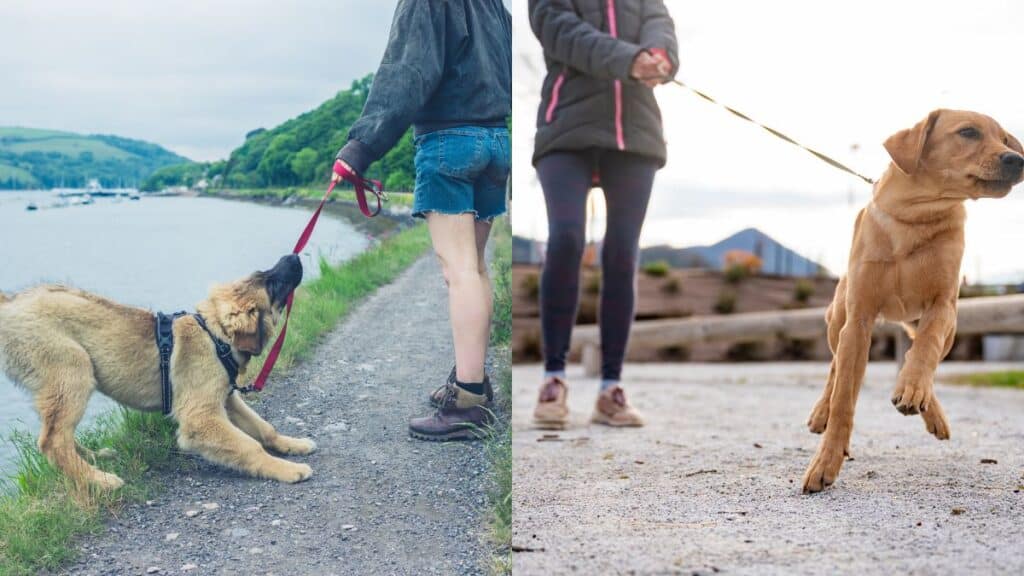Leash training issues can make walks with your dog stressful and frustrating. However, with the proper techniques and solutions, you can overcome these challenges and achieve a smooth and enjoyable walk. This article will explore common problems such as pulling, lunging, leash biting, and refusing to walk and provide practical solutions for each issue. We will also discuss additional tools and when to seek professional help. With patience, practice, and the right approach, you can successfully troubleshoot leash training issues and have a pleasant walking experience with your furry friend.

Key Takeaways:
- Identify the specific leash training issues you are facing with your dog
- Implement targeted solutions for everyday problems such as pulling, lunging, leash biting, and refusing to walk
- Consider using additional tools such as harnesses and speciality leashes for better control and comfort
- Seek professional help if the issues persist or if there are underlying medical or behavioral concerns
- Track your progress and celebrate each small success to stay motivated throughout the training process
Pulling: The Most Common Culprit
Pulling on the leash is one of the most common leash training issues dog owners face. It can turn a pleasant walk into a frustrating struggle. Understanding the reasons behind this behavior is the first step in resolving it. This section will address the various causes of pulling and provide effective solutions for each issue.
Excitement or Overwhelm: Teaching Calmness and Focus Around Distractions
Many dogs pull on the leash due to excitement or being overwhelmed by the environment. To teach your dog calmness and focus, it’s essential to gradually expose them to distractions and reward them for maintaining their attention on you. Start with low-distraction environments and progressively increase the difficulty level as your dog becomes more focused.
Instinctive Opposition Reflex: Techniques to Reduce Tension
The instinctive opposition reflex, where dogs naturally push against pressure on the leash, can contribute to pulling. To reduce tension, use techniques such as changing direction when your dog pulls, rewarding them for walking by your side and using a front-clip harness that discourages pulling.
Leash as a Toy: Redirecting Playful Energy
Some dogs view the leash as a toy and engage in play behavior while walking. To redirect their playful energy, provide them with appropriate toys and playtime before going for a walk. Use positive reinforcement to reward calm walking behaviors and discourage any leash play.

Lunging: Managing Sudden Surges
Lunging is another common leash training issue that can be challenging to manage. This section will address different types of lunging behavior, such as reactivity towards dogs/people, prey-drive triggered lunges, and fear-based lunging. We will provide strategies for desensitization and counter-conditioning to reduce reactivity, techniques for redirecting prey drive, and confidence-building exercises for fearful dogs. By implementing these strategies, you can help your dog remain calm and controlled during walks.

Reactivity Towards Dogs/People: Desensitization and Counter-Conditioning Strategies
Reactivity towards dogs or people while on a leash can make walks stressful. Desensitization and counter-conditioning are effective strategies for managing this behavior. The goal is to gradually expose your dog to triggers in a controlled and positive way, helping them associate these stimuli with calmness and positive experiences.
Start by identifying the distance at which your dog becomes reactive and slowly increase it over time. Use high-value rewards, such as treats or toys, to reward calm and non-reactive behavior. As your dog becomes more comfortable, gradually decrease the distance between them and the trigger, ensuring they remain relaxed. Repeat these exercises regularly to reinforce positive associations and build confidence.
Prey Drive Triggered Lunges: Redirection and Strong Impulse Control Training
Dogs with strong prey drives may lunge at small animals or move objects on a leash. Redirection and impulse control training can help manage this behavior and redirect their focus.
Carry toys or treats during walks and redirect your dog’s attention to them whenever they show signs of prey-driven lunging. Engage them in a game of fetch or reward them with treats for maintaining focus on you. Incorporate impulse control exercises into their training routine, such as “leave it” or “watch me” commands, to teach them self-control and reinforce their ability to resist impulses.
Fear-Based Lunging: Confidence-Building Exercises
Dogs that lunge out of fear on walks require confidence-building exercises to help them feel more secure and reduce reactive behavior.
Provide your dog with a safe and controlled environment to gradually expose them to what they fear. Start with low-intensity stimuli and progressively increase the difficulty level. Reward calm behavior and use positive reinforcement techniques like clicker training or treats to create positive associations with the feared stimuli. Building your dog’s confidence through training and socialization can reduce fear-based lunging.
| Lunging Behavior | Strategies |
| Reactivity Towards Dogs/People | Desensitization and counter-conditioning |
| Prey Drive Triggered Lunges | Redirection and impulse control training |
| Fear-Based Lunging | Confidence-building exercises |
Leash Biting: When Play Turns Problematic
Teething Puppies: Providing appropriate chew alternatives
Teething puppies often bite anything they can get their paws on, including their leash. To address this behavior, it’s crucial to provide appropriate chew alternatives that satisfy their need to gnaw. Consider offering durable chew toys specifically designed for teething puppies. These toys not only provide relief for their sore gums but also divert their attention away from the leash. Make sure to have a variety of textures and shapes to keep them engaged and interested. You can prevent them from targeting the leash during walks by redirecting their biting behaviour towards these chew toys.
Attention-Seeking Behavior: Rewarding calm walking, ignoring disruptive attempts
Some dogs may bite the leash to seek attention or engage in playful behavior during walks. Establishing rules and boundaries is essential to discourage this attention-seeking behavior. Reward your dog for walking calmly by praising them and providing treats when they exhibit the desired behavior. Consistency is vital in reinforcing this positive association. However, ignoring disruptive attempts such as leash biting or pulling is equally essential. By refusing to engage these behaviors, your dog will understand that leash biting does not lead to attention or playtime and will eventually stop the unwanted behavior.
Boredom or Frustration: Increasing mental and physical stimulation before walks
Leash biting can also be a result of boredom or frustration. Dogs with excess energy may resort to leash biting to release pent-up energy. To address this, providing adequate mental and physical stimulation before walks is essential. Engage in interactive play sessions, puzzle toys, or obedience training to tire them out mentally. Additionally, consider increasing the duration or intensity of exercise to ensure they are physically tired. A tired dog is less likely to engage in leash biting during walks. Increasing mental and physical stimulation can make walks more enjoyable and reduce leash-biting behaviour.
Stopping or Refusing to Walk
If your dog stops or refuses to walk during leash training, there may be underlying reasons for this behavior. Understanding and addressing these issues is crucial to ensure a smooth walking experience with your furry friend. This section will explore different causes for stopping or refusing to walk and provide practical strategies to overcome them.
Exploring Fear or Anxiety: Creating positive associations with the outdoors, gradual exposure
Fear or anxiety can often contribute to a dog’s reluctance to walk on a leash. Creating positive associations with the outdoors and gradually exposing your dog to new environments is essential to help them feel more comfortable. Start by taking short walks in familiar and low-stress areas, and progressively increase the duration and complexity of the walks. Reward your dog with treats and praise for calm behavior, and use gentle encouragement to help build their confidence.
Pain or Discomfort: Veterinary checks to rule out medical causes
If your dog suddenly stops walking or shows signs of discomfort, it’s essential to rule out any potential medical causes. Schedule a visit with your veterinarian to assess your dog’s physical health and discuss any pain or discomfort they may be experiencing. Addressing any underlying medical issues will improve their comfort and restore their willingness to walk on a leash.
Confusion or Lack of Motivation: Short, fun training sessions with clear goals
Some dogs may stop or refuse to walk due to confusion or lack of motivation. To overcome this, engage your dog in short, fun training sessions focused on leash walking. Set clear goals and reward your dog for their efforts and achievements. Incorporate interactive toys or games during breaks to make the training sessions enjoyable and motivate your dog. Consistency and positive reinforcement will help your dog understand the expectations and encourage them to walk on a leash.
Addressing the underlying causes for stopping or refusing to walk is essential for successful leash training. By creating positive associations with the outdoors, ruling out medical causes, and increasing motivation through short, fun training sessions, you can overcome these challenges and have a pleasant walking experience with your dog.
Beyond Basic Commands: Additional Tools
In addition to teaching basic commands, several additional tools and techniques can significantly assist in leash training your dog. These tools can help address specific issues, enhance training effectiveness, and make your walks more enjoyable for you and your furry companion.
Equipment Check: Harnesses vs. Collars, Leash Choice, Specialty Tools
Choosing the right equipment is crucial for successful leash training. Consider your dog’s breed, size, and behavior when it comes to harnesses versus collars. Harnesses provide better control and minimize strain on the neck, making them ideal for dogs prone to pulling. Conversely, collars may be suitable for dogs that are already well-behaved on the leash.
Additionally, selecting the appropriate leash is essential. Opt for a robust, comfortable leash and the correct length for your training needs.
Sometimes, unique tools like head halters or no-pull harnesses can be helpful for dogs with severe pulling or lunging behaviours. Consult a professional trainer or behaviorist to determine if these tools suit your dog’s specific needs.
Harnessing the Power of Rewards: Identifying Your Dog’s Favorite Motivators
Using rewards is an effective way to motivate and reinforce desired behaviors during leash training. Every dog is unique when it comes to what motivates them. Take the time to identify your dog’s favorite motivators, such as treats, toys, praise, or playtime. Utilizing these preferred rewards can encourage your dog to stay focused, engaged, and attentive during walks.
Environmental Control: Adjusting Walk Times, Routes, and Managing Triggers
Environmental factors play a significant role in leash training. Consider adjusting your walk times to avoid peak hours when there may be more distractions or triggers for your dog. Choose quieter, less stimulating routes initially and gradually increase the difficulty level as your dog becomes more comfortable and responsive.
Additionally, be mindful of triggers that may cause your dog to react negatively, such as other dogs, loud noises, or crowded areas. Practice techniques like desensitization and counter-conditioning to help your dog remain calm and controlled in the presence of these triggers.
Incorporating these additional tools and techniques into your leash training routine can increase your chances of success and allow you to enjoy peaceful walks with your beloved canine companion.
When to Seek Professional Help
In some cases, leash training issues may persist despite adequate efforts. If you’re facing severe or ongoing problems, seeking professional help can be a beneficial step towards resolving the training challenges. There are various situations where collaborating with a professional can make a significant difference in overcoming leash training issues.
Persistent Severe Issues: Trainers vs. Behaviorists
When dealing with severe leash training issues, assessing whether a trainer or a behaviorist is the proper professional to consult is essential. Trainers specialize in teaching dogs basic obedience and can help with leash training techniques. On the other hand, behaviorists have expertise in modifying behavior and addressing more complex issues. Depending on the severity and nature of the problem, you may need to seek assistance from a behaviorist who can develop a tailored training plan to address the underlying causes of the behavior.
Medical Conditions Impacting Behavior: Collaboration with a Veterinarian
Sometimes, medical conditions that impact your dog’s behavior may influence leash training issues. If your dog is displaying sudden and uncharacteristic behavioral changes during leash training, it’s essential to collaborate with a veterinarian. A comprehensive physical examination and relevant diagnostic tests can help rule out any underlying medical conditions contributing to the behavior problems. You can ensure a holistic approach to leash training by addressing the medical aspect.
Breed-Specific Considerations: Understanding Tendencies and Working with Qualified Specialists
Every dog breed possesses unique characteristics and tendencies that can influence their leash training. Some breeds may be predisposed to certain behaviors or require specialized training techniques. Working with qualified specialists who understand these breed-specific considerations can be highly beneficial. They can provide targeted guidance and training strategies that align with your dog’s breed-specific needs, increasing the effectiveness of the training and promoting better results.
To ensure the better outcome for your dog’s leash training, it’s important to recognize when seeking professional help is necessary. Whether it’s working with a behaviorist, collaborating with a veterinarian, or consulting breed-specific specialists, the expertise and guidance provided by professionals can be invaluable in overcoming challenging leash training issues. By taking this proactive approach and seeking professional assistance, you can navigate the difficulties and achieve the desired results in your dog’s training journey.
Wrapping Up: Patience, Practice, and Progress
In this final section, we want to emphasize the three key factors leading to success in leash training: patience, practice, and progress. The journey to achieving a smooth walking experience with your dog requires dedication, consistency, and a positive mindset.
This article has provided many strategies and techniques for troubleshooting leash training issues. Whether it’s addressing pulling, lunging, leash biting, or refusing to walk, each problem has its own set of solutions.
However, it’s important to remember that leash training takes time. Patience is critical as you work with your dog to overcome these challenges. Consistent practice of the techniques discussed will help reinforce positive behavior and create new habits. And as you put in the effort, track your progress. Celebrate each small victory along the way! This will motivate both you and your furry friend to keep moving forward.
By staying committed to the process and implementing the strategies outlined in this article, you can overcome leash training issues and enjoy peaceful walks with your dog. Remember, it’s not about perfection but rather the progress you make together. So, embrace the journey and watch your bond with your canine companion grow stronger with each successful walk.
FAQ
What are some common leash training issues faced by dog owners?
Common leash training issues include pulling, lunging, leash biting, and refusing to walk.
How can I address pulling behavior during leash training?
To address pulling behavior, you can teach calmness and focus around distractions, reduce tension caused by the opposition reflex, and redirect playful energy.
How can I manage lunging behavior on a leash?
To manage lunging behavior, you can use desensitization and counter-conditioning techniques, redirect prey drive, and employ confidence-building exercises for fearful dogs.
What are some strategies to discourage leash biting?
Strategies to discourage leash biting include providing appropriate chew alternatives, rewarding calm walking, and increasing mental and physical stimulation.
What can I do if my dog stops or refuses to walk on a leash?
If your dog stops or refuses to walk, you can create positive associations with the outdoors and veterinary checks to rule out medical causes and increase motivation through short, fun training sessions.
Are there additional tools and techniques that can aid in leash training?
Choosing the right equipment like harnesses or collars, identifying your dog’s favorite motivators, and managing triggers can enhance leash training.
When should I seek professional help for leash training?
You should seek professional help for persistent severe issues, collaborate with a veterinarian to rule out medical conditions, and consider breed-specific considerations for leash training.
What is the importance of patience, practice, and progress in leash training?
To achieve success, patience, practice, and progress are crucial in leash training. Consistent effort and tracking progress can lead to a smooth walking experience.

